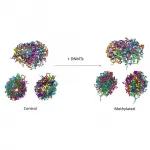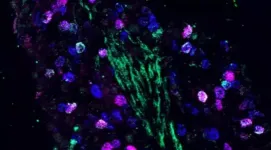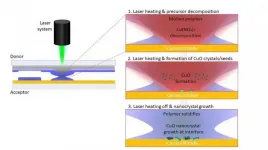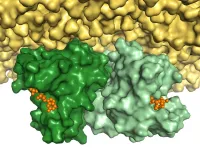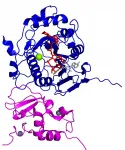Acoustic solutions made from natural fibers can reduce buildings' carbon footprints
Aalto University researchers discovered that wood-based pulp fibers are also well-suited for making acoustic materials
2021-06-02
(Press-News.org) Good acoustics in the workspace improve work efficiency and productivity, which is one of the reasons why acoustic materials matter. The acoustic insulation market is already expected to hit 15 billion USD by 2022 as construction firms and industry pay more attention to sound environments. Researchers at Aalto University, in collaboration with Finnish acoustics company Lumir, have now studied how these common elements around us could become more eco-friendly, with the help of cellulose fibres.
'Models for acoustic absorption are based on tests done with synthetic fibres, and natural fibres don't adhere to these models. With natural fibres like cellulose, we can use thinner structures to achieve the same sound absorption as synthetic fibres,' says Jose Cucharero, a doctoral student at Aalto University.
Cucharero's research explores the effect of natural fibres' properties on sound absorption and how these fibres can be used in room acoustics. Synthetic fibres, such as fibreglass and rockwool, are uniform in quality. Cellulose fibres have a complex structure with natural irregularities, which can be an asset for absorbing sound indoors. The origin of fibres also seems to matter: his research has found that hardwood fibres absorb sound better than softwood fibres. Based on the research, this can be attributed to the smaller dimensions of the hardwood fibres.
In addition to their excellent acoustic properties, cellulose fibres also have positive environmental impacts compared to traditional acoustic materials. The production of cellulose fibres is considerably more energy-efficient, and the fibres also absorb significant amounts of carbon dioxide from the atmosphere. Using the fibre in construction materials is an effective way to store carbon: buildings last for decades, unlike single-use packaging and paper where cellulose is typically used.
'Acoustics solutions based on cellulose fibres can be applied to a wide range of facilities. For example, acoustic sprays -- which can be used on any surface to create a porous, sound-absorbing layer -- can significantly improve the comfort of buildings under renovation without changing their visual appearance,' Cucharero says.
Research results are already used in product development
Alongside his doctoral dissertation, Jose Cucharero works at Lumir Oy, which produces acoustic solutions in line with the principles of the circular economy. The results of the dissertation are used in the development of new cellulose-based acoustics solutions, and the study has been rapidly applied in product development.
The commercial perspective is also complemented by tests that ensure the products' scalable manufacturing and fire resistance. Based on the results, an industrially scalable process has been developed for the production of acoustic panels based on cellulose fibres.
'Governments around the world have set out to become carbon neutral. We can't achieve this by simply reducing emissions; we need to also absorb carbon dioxide from the atmosphere and store it in products.' , says Lumir's R&D Director Tuomas Hänninen, Doctor of Technology and Jose Cucharero's thesis advisor.
INFORMATION:
Findings have been most recently published in Frontiers of Built Environment and Cellulose.
[Attachments] See images for this press release:
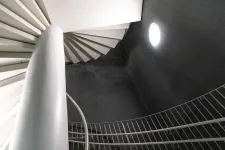
ELSE PRESS RELEASES FROM THIS DATE:
2021-06-02
An international research team determined that ancestors of modern domestic horses and the Przewalski horse moved from the territory of Eurasia (Russian Urals, Siberia, Chukotka, and eastern China) to North America (Yukon, Alaska, continental USA) from one continent on another at least twice. It happened during the Late Pleistocene (2.5 million years ago - 11.7 thousand years ago). The analysis results are published in the journal. The findings and description of horse genomes are published in the journal Molecular Ecology.
"We found out that the Beringian Land Bridge, or the area known as Beringia, influenced genetic ...
2021-06-02
All the cells of an organism share the same DNA sequence, but their functions, shapes or even lifespans vary greatly. This happens because each cell "reads" different chapters of the genome, thus producing alternative sets of proteins and embarking on different paths. Epigenetic regulation--DNA methylation is one of the most common mechanisms--is responsible for the activation or inactivation of a given gene in a specific cell, defining a secondary cell-specific genetic code.
Researchers led by Dr. Modesto Orozco, head of the Molecular Modelling and Bioinformatics lab at IRB Barcelona, have described how methylation has a protein-independent regulatory role by increasing the stiffness of DNA, which affects the 3D structure ...
2021-06-02
Autistic people's ability to accurately identify facial expressions is affected by the speed at which the expression is produced and its intensity, according to new research at the University of Birmingham.
In particular, autistic people tend to be less able to accurately identify anger from facial expressions produced at a normal 'real world' speed. The researchers also found that for people with a related disorder, alexithymia, all expressions appeared more intensely emotional.
The question of how people with autism recognise and relate to emotional expression has been debated by scientists for more than three decades and it's only in the past 10 years ...
2021-06-02
The gut and the brain communicate with each other in order to adapt satiety and blood sugar levels during food consumption. The vagus nerve is an important communicator between these two organs. Researchers from the Max Planck Institute for Metabolism Research in Cologne, the Cluster of Excellence for Ageing Research CECAD at the University of Cologne and the University Hospital Cologne now took a closer look at the functions of the different nerve cells in the control centre of the vagus nerve, and discovered something very surprising: although the nerve cells are located in the same control center, they innervate different regions of the gut and also differentially control satiety and blood sugar levels. This discovery could play an important role in the development of future ...
2021-06-02
In the journal Nature Communications, an interdisciplinary team from the Max Planck Institute of Colloids and Interfaces presents for the first time a laser-driven technology that enables them to create nanoparticles such as copper, cobalt and nickel oxides. At the usual printing speed, photoelectrodes are produced in this way, for example, for a wide range of applications such as the generation of green hydrogen.
Previous methods produce such nanomaterials only with high energy input in classical reaction vessels and in many hours. With the laser-driven technology developed at the institute, the scientists can deposit small amounts of material on a surface and simultaneously perform chemical synthesis in a very short time using high temperatures from the laser. 'When I discovered ...
2021-06-02
A facial expression or the sound of a voice can say a lot about a person's emotional state; and how much they reveal depends on the intensity of the feeling. But is it really true that the stronger an emotion, the more intelligible it is? An international research team comprised of scientists from the Max Planck Institute for Empirical Aesthetics, New York University, and the Max Planck NYU Center for Language, Music, and Emotion (CLaME) has now discovered a paradoxical relationship between the intensity of emotional expressions and how they are perceived.
Emotions ...
2021-06-02
Researchers from Bochum and Osnabrück have gained new insights into the structure of the Ras protein, which acts as a molecular switch for cell growth and is involved in the development of cancer. With the help of fluorescence markings, they have demonstrated that the protein is deposited in a pair at the cell membrane, and with the very structure that they predicted in theory back in 2012. The team from the Bochum Center for Protein Diagnostics (PRODI) hopes that these findings will open up a new approach for the development of cancer medications. The researchers from Ruhr-Universität Bochum (RUB) and Osnabrück University ...
2021-06-02
Prenuptial agreements, or "prenups," can be difficult to talk about. But a recent study offers insights into how people can discuss this often taboo subject. One approach? Use metaphors.
"Many people view prenups as being negative, and argue that they indicate a lack of faith in the marriage from the outset," says Lynsey Romo, corresponding author of the study and an associate professor of communication at North Carolina State University. "By the same token, we know from other research that open communication about financial issues contributes to successful relationships.
"And yet there is virtually no academic research on prenups. So how do people talk about prenups? How do they make sense of them? That's what we wanted ...
2021-06-02
SAN ANTONIO (June 2, 2021) -- Scientists from The University of Texas Health Science Center at San Antonio have discovered a mechanism by which SARS-CoV-2 exploits changes in metal ion concentrations to disguise itself in the body. Varying concentrations of metal ions -- positively charged atoms such as magnesium, manganese and calcium -- are observed in hospitalized COVID-19 patients.
"This is a newly described metal-dependent mechanism by which these ions help the virus to evade immune surveillance," said END ...
2021-06-02
RUDN University chemists proposed a new way to synthesize catalysts for the conversion of ethyl alcohol. The obtained materials are promising catalysts for the selective conversion of ethanol, which is an important stage in the development of an alternative technology for obtaining valuable chemical synthesis products based on plant raw materials. The results of the study are published in Catalysis Today.
Ethanol fuel is ethyl alcohol, it is produced from plant material by fermentation of industrial or agricultural waste biomass. It is used as a more environmentally ...
LAST 30 PRESS RELEASES:
[Press-News.org] Acoustic solutions made from natural fibers can reduce buildings' carbon footprints
Aalto University researchers discovered that wood-based pulp fibers are also well-suited for making acoustic materials


